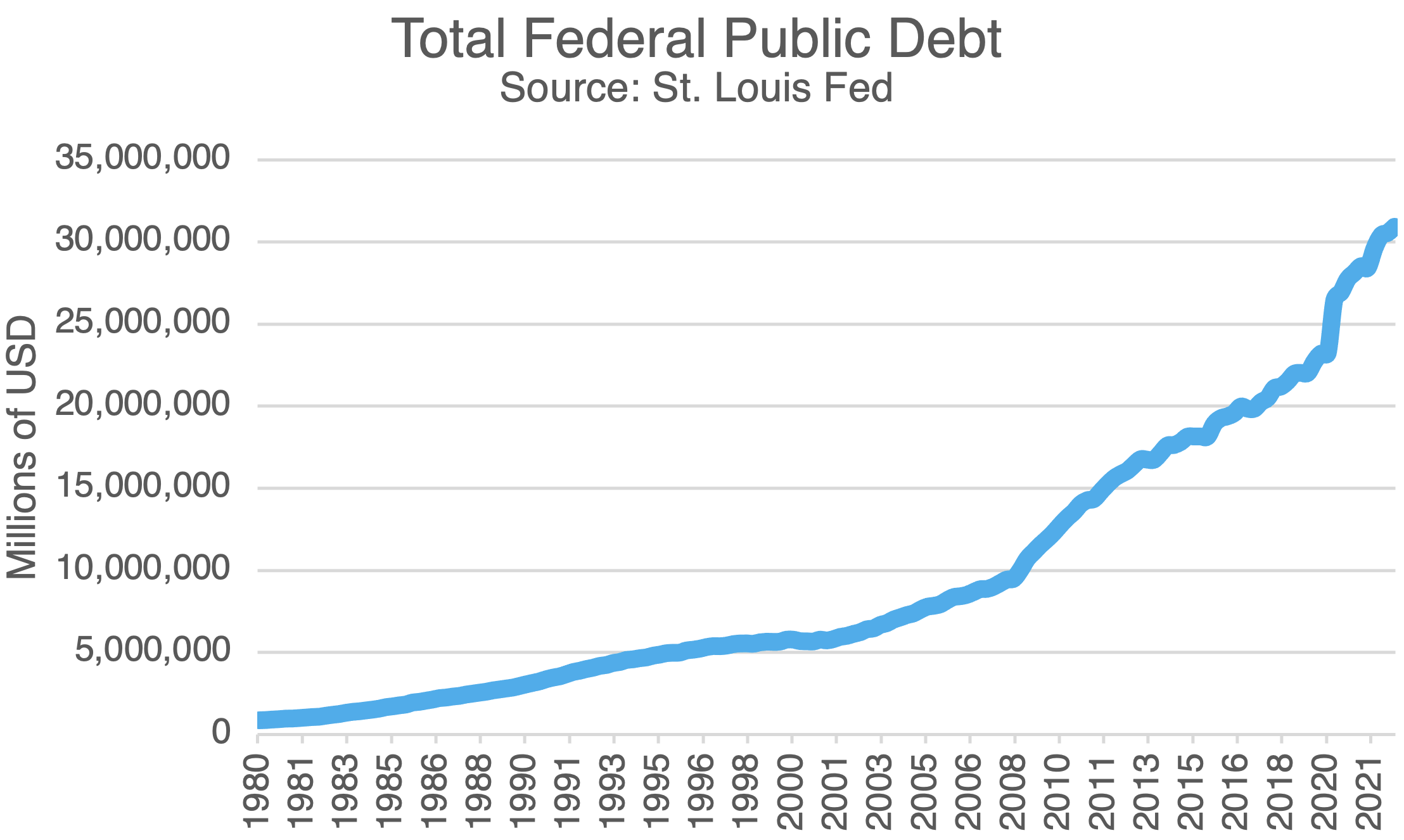March 7, 2023
A trillion dollars is a lot of money. It is so unfathomable that most people do not even attempt to understand it. Do you know how long it would take to count to a trillion dollars, one dollar per second? (The answer later.) Now, let us try to consider $30 trillion which is our current national debt. It is mind numbing and continuing to grow. If one was to take the average annual increase in debt over the last 10 non-COVID years (i.e. excluding the 20% jump in debt in 2020), it comes out to be about 6% per year. Using the Rule of 72, continuing this pace would see our debt level double in 12 years.
This astronomical jump in debt is often politicized with each side blaming the other, but it is evident that neither side has been immune to spending today by borrowing from tomorrow. According to the OMB and St. Louis Federal Reserve, our national debt-to-GDP has soared from about 60% in 2000 to 120% today. That covers a lot of time with each party in control. The chart below shows the debt growth since 1980 including the past twenty years of borrowing overdrive.

This issue is in the headlines because we are approaching another debt ceiling circus in Washington. Since mid-January of this year, the government has been over its $31.38 trillion debt ceiling. Right now, the Treasury Department is effectively kiting checks by not paying some bills in order to avoid a general default. These financial acrobatics will be exhausted in early June. Between now and then, expect there to be much public posturing about “real” and “lasting” solutions to the problem. The most likely outcome will be leadership kicking the can down the road for another day by raising the debt ceiling but not making any fundamental changes to the budget, let alone having a plan for the deficit. Expect angsty, hot air-filled posturing with both sides screaming into their respective echo chambers about the irresponsibility of the other side. The closer they push this toward the June deadline, the more investors can expect heightened volatility in the capital markets.
As Americans, we have been lucky that the markets have to-date funded our profligate spending at modest interest rates. We have benefited from the fact that there is no alternative to the dollar as the world’s reserve currency. Historically viewed, this pass on overleverage does not last forever. You need only to look back on the Romans, the Spanish, and the British to see what happens when investors lose faith in the world’s safest currency. It does not end well. There are numerous economic and geopolitical benefits that come from being the superpower that prints the world’s reserve currency. For no other reason than that, it would be imprudent to test the market too often with these fictitious debt ceilings. Since 1960, the debt ceiling has been raised 78 total times. Why keep challenging the market to reconsider whether we are good for our debt?
To count to a trillion dollars at one dollar per second would take almost 37,000 years. To count to $30 trillion would take almost a million years. We are not going to solve these problems in a day, but the level and trajectory of our debt load does not appear to give us 30,000 years of runway. At some point both sides are going to realize that they each must give a little – this is both a revenue and expenditure problem – to make any headway in solving what seems to be one of the biggest undiscussed issues facing the long-term stability of our country. We would love to hear your thoughts on this or any other financial matter.
This material is prepared by Cornerstone Advisors Asset Management, LLC (“Cornerstone”) and is not intended to be relied upon as a forecast, research or investment advice, and is not a recommendation, offer or solicitation to buy or sell any securities or to adopt any investment strategy. The opinions expressed are as of the published date indicated on the article and may change as subsequent conditions vary. The information and opinions contained in this material are derived from proprietary and nonproprietary sources deemed by Cornerstone to be reliable, are not necessarily all inclusive and are not guaranteed as to accuracy. As such, no warranty of accuracy or reliability is given and no responsibility arising in any other way for errors and omissions (including responsibility to any person by reason of negligence) is accepted by Cornerstone, its officers, employees or agents. This material may contain ‘forward looking’ information that is not purely historical in nature. Such information may include, among other things, projections and forecasts. There is no guarantee that any forecasts made will come to pass. Reliance upon information in this material is at the sole discretion of the reader.
Any accounting or tax advice contained in this communication is not intended as a thorough, in-depth analysis of specific issues, nor a substitute for a formal opinion, nor is it sufficient to avoid tax-related penalties.
The information is provided solely for informational purposes and therefore should not be considered an offer to buy or sell a security. Except as otherwise required by law, Cornerstone shall not be responsible for any trading decisions or damages or other losses resulting from this information, data, analyses or opinions or their use. Please read any prospectus carefully before investing.



